How To Create A News Aggregator
How to Create An Aggregator Website And Why You Should
Marketing is always changing and technology has made it seem like there's a new way to market your brand every single day. Your audience is already innudated with marketing content. They want something more valuable for their time. This is where content aggregation comes in.
A content aggregator website presents an exciting content marketing opportunity for any business owner. Whether your intention is to reach out to a new audience or just get noticed, content curation is your best bet. In this post we shall focus on how you can build your aggregator website and why you should. So, let's dive in and explore.
Curator.io is an easy-to-customize aggregator that lets you pull from over a dozen sources. If you'd like to give Curator.io's free forever plan a spin sign up today.
What is a content aggregator website?
A content aggregator website is a site that collects data from other sources across the internet and puts the information in one place where users can access it. The data collected can be based on many things, depending on the channel or platform it's pulling from...
- A certain hashtag
- A certain user account
- A keyphrase
- A channel
- A playlist
Each platform or source will have it's own unique possibilities. For example, using a hashtag is a common way to aggregate Instagram content, while with YouTube, you wouldn't aggregate hashtags, but you might aggregate content from a YouTube channel or specific playlist. For example third party websites where users can watch YouTube together. 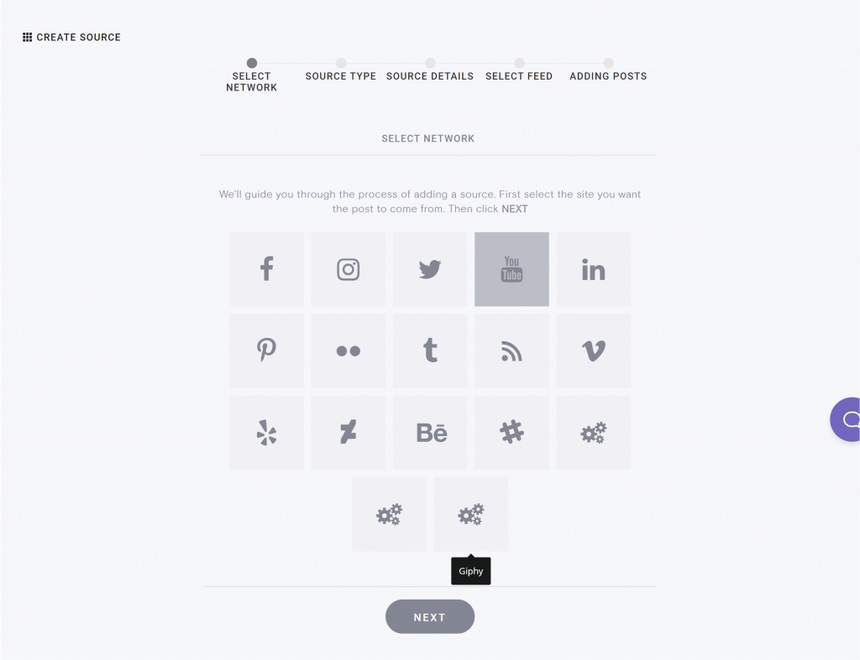 With Curator.io you can aggregate content from the following sources:
With Curator.io you can aggregate content from the following sources:
- Facebook - add company posts, employee advocacy posts, or user generated content from customers and followers
- Instagram - add company posts, employee advocacy posts, or user generated content from customers and followers
- Twitter - add company posts, employee advocacy posts, or user generated content from customers and followers
- YouTube - add company videos, customer videos, testimonials, and/or content that aligns with your brand
- LinkedIn - add company posts, employee advocacy posts, or user generated content from customers and followers
- Pinterest - add company posts, employee advocacy posts, or user generated content from customers and followers
- Flickr - add company posts, employee advocacy posts, or user generated content from customers and followers
- Tumblr - add company posts, employee advocacy posts, or user generated content from customers and followers
- RSS - add your own blog posts, customer posts, employee advocacy posts, or industry content from non-competitors
- Vimeo - add company videos, customer videos, testimonials, and/or content that aligns with your brand
- Yelp - add reviews for your business
- DeviantArt - add team art and fan art
- Behance - add team art and fan art
- Slack - pull in community conversations
- Glassdoor - add reviews of your workplace in your hiring assets
- Diffbot - add custom code or any element from other sites via API
- Giphy - Add gifs that align with your brand
It is common for people to confuse content aggregation with plagiarism. The two are however very different. Plagiarism involves the use of other peoples content without permission while content aggregation involves the use of content from various online platforms while giving due credit to the owner.
The owner's name, website and links are all kept in place. All you're doing is making it easier for your readers to find more content that's useful to them.
Why doesn't this create competition?
It's easy to think that having an aggregator website might actually serve as competition for your brand. In the past, everyone was the competition. Now, brands can help each other out without losing anything. While you might not see two direct competitors helping each other, aggregating content from indirect competitors and other brands helps everyone involved. The best part is your audience loves it! Customers don't just see brands as objects. Instead, they are like individual people who they want to build relationships with. With so many different brands, customers prefer brands who work to build lasting relationships. Great products and services are a must. However, you have to prove you value your customers' time by giving them more. Marketing content is all about your brand. Providing high-quality, useful content on a regular basis proves you care about their needs. Yet, this is incredibly time consuming and difficult to do. You don't have to do it all alone. A content aggregator website allows your brand to find relevant content from other sources, including other brands. Other brands benefit from the exposure and your brand builds a stronger relationship with your customers.
Curator.io is an easy-to-customize aggregator that lets you pull from over a dozen sources. If you'd like to give Curator.io's free forever plan a spin sign up today.
How do you create an aggregator website?
Creating an aggregator website is super simple. All you need to do is use an aggregator like Curator.io (check out our free and paid plans), pull in your sources, curate your feed, and copy some code onto a page of your site. Step 1: Select a source Let's say you want to aggregate a YouTube playlist in your website. 
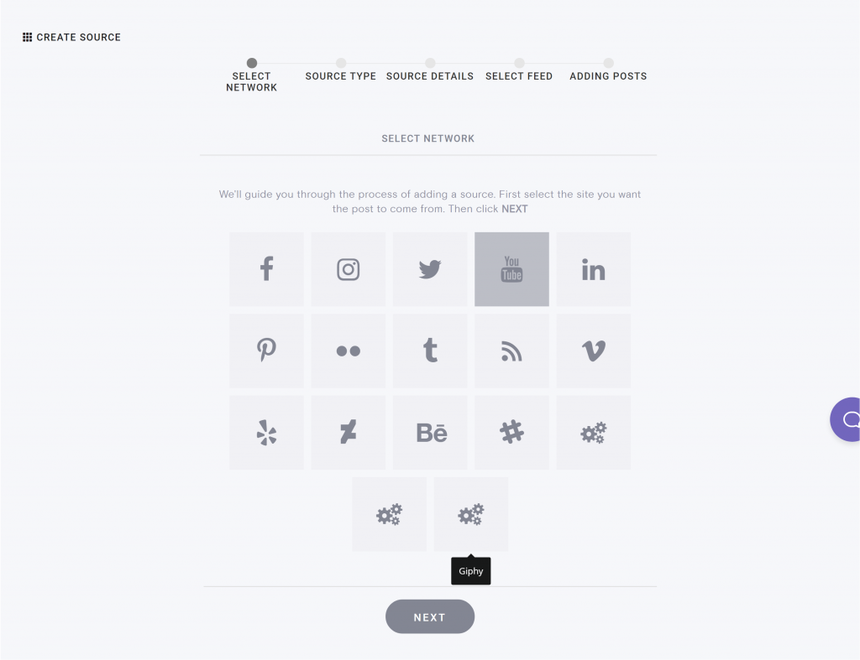 Step 2: Select a source type For each platform or channel, you'll need to select the source type, be it a hashtag or something else.
Step 2: Select a source type For each platform or channel, you'll need to select the source type, be it a hashtag or something else. 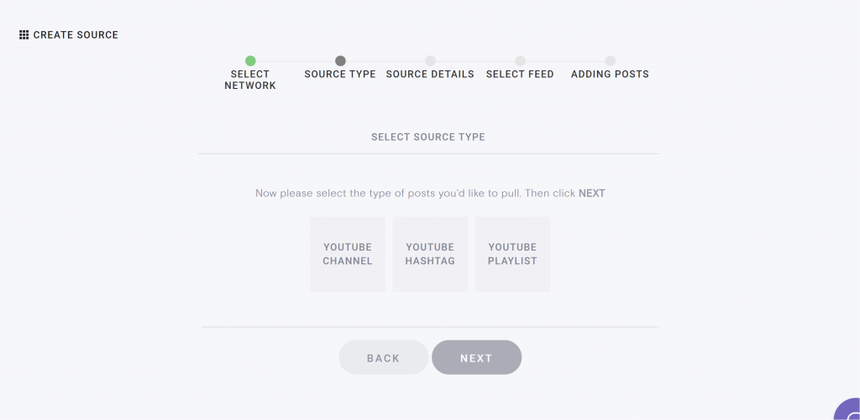 Step 3: Add the URL, RSS, hashtag, or whatever is required for that source type Then add what URL or hashtag you need to for that source.
Step 3: Add the URL, RSS, hashtag, or whatever is required for that source type Then add what URL or hashtag you need to for that source. 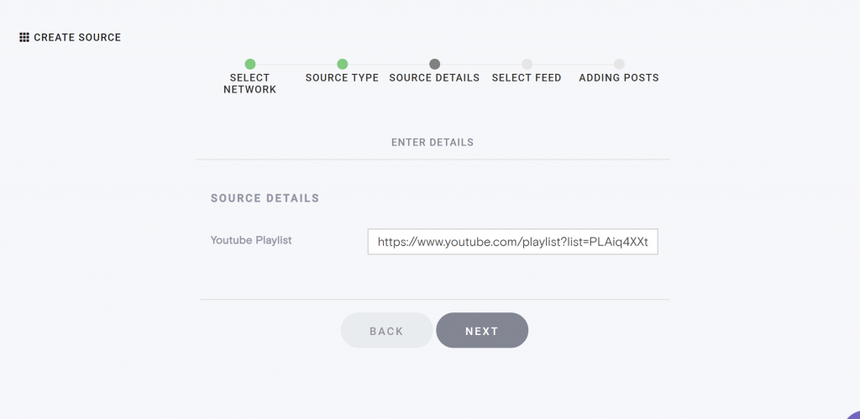 Step 4: Embed the code and check out your new website aggregator! Before you embed, you can also customize your aggregator by deleting any posts you don't like, changing the layout, or updating the font colors and styles.
Step 4: Embed the code and check out your new website aggregator! Before you embed, you can also customize your aggregator by deleting any posts you don't like, changing the layout, or updating the font colors and styles. 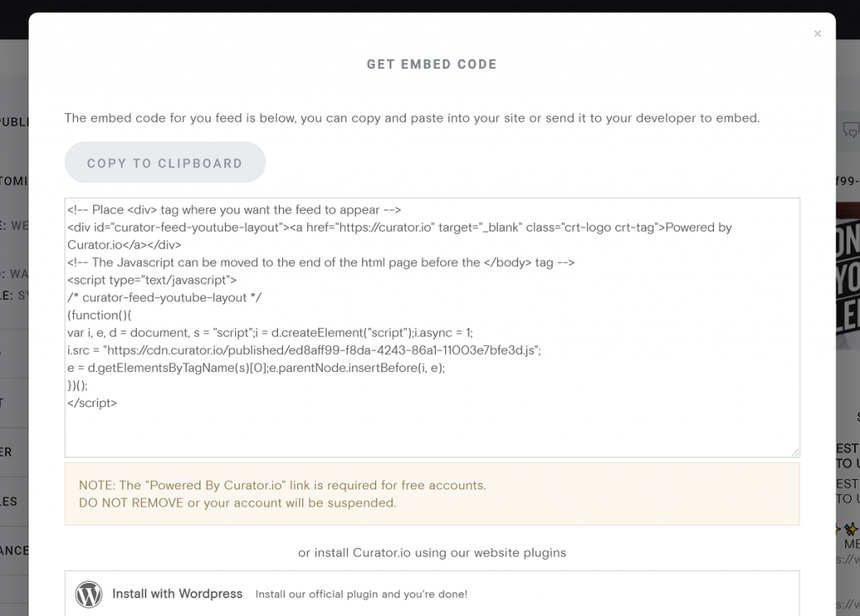 After you embed the code in your website, you'll have ready-to-go content. You can use this concept for blog posts, social media posts, reviews, anything you want!
After you embed the code in your website, you'll have ready-to-go content. You can use this concept for blog posts, social media posts, reviews, anything you want! 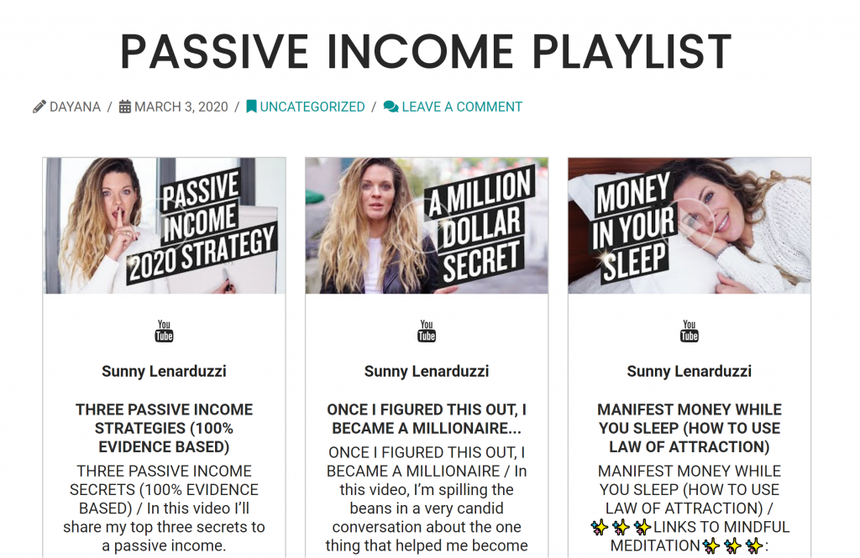 If you want the main site to be the aggregator, then put the code in the homepage. If you just want to put some aggregated content in a side bar, copy the code there. If you want in a blog, put the feed's embed code in a blog. You get the picture.
If you want the main site to be the aggregator, then put the code in the homepage. If you just want to put some aggregated content in a side bar, copy the code there. If you want in a blog, put the feed's embed code in a blog. You get the picture.
How to aggregate content effectively
As with every marketing strategy, there is a right and a wrong way to aggregate content. You could easily just start pulling a bunch of content from any source that sounds remotely related to your brand. Or, you can take your time and do it the right way, which is the far more effective method.
Use credible sources
Ensure that you aggregate content from sites that can be trusted. Double-check the information you have gathered to be sure that the topics selected are relevant to your target audience. Spot check a few pieces of content to ensure the content is correct, current and any links work correctly. You can also check the domain authority to see if the source is credible.
Add value
Enrich the quoted information by adding your views as well as excerpts from other sources that support the quoted text. For instance, you can tell your readers what you feel about the information given. Do you agree with it? Is there information that was missed when writing the text? Giving your thoughts proves you're doing more than just pushing content at your audience. You're taking the time to make it even more useful.
Consider what type of content fits your brand's personality and values. The last thing you want is contradictory content that confuses your audience. For example, if your content team doesn't have time to create outstanding YouTube content for your audience, maybe you can instead aggregate content from your favorite content creators. Add in your favorites as sources to the same feed, and then trash any posts that you don't want to include. 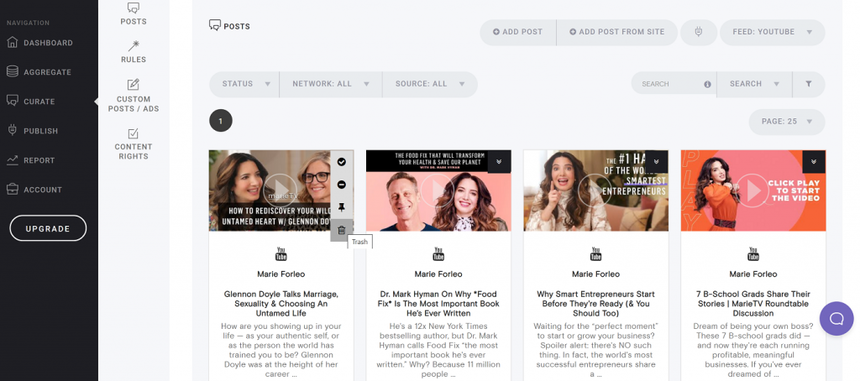
Summarize
Make it easier for the readers to get the information in less time by making a summary of the major points discussed. Help them see whether a specific piece of content truly is relevant to them.
Give proper credits
Give sources for all the information you gather. This will allow your readers to get more information from the original authors and publications. Never take shortcuts on this one. If you don't give credit, this is plagiarism and Google can and will penalize your site for it. You want to stay in Google's good graces or all this effort will be for nothing.
Use SEO
The content you gather might not have proper SEO. It is your duty as a content aggregator to optimize the content you collect so that it can be found easily. This is another reason to be careful about the sources you use. Credible sources are typically SEO optimized, which makes your job easier.
Encourage discussion
Ask questions to your readers and encourage the writers of the articles to provide answers to questions asked by the readers. Answering questions from your readers demonstrates your expertise to them, which in turn helps them trust you more.
You can reach out to site owners before you start aggregating content to let them know to check out your site and participate if they want. Once again, it's a win-win for both of you.
Content aggregation tool to help you boost your content
Gone are the days when businesses would manually curate information from influencers and industries to find useful information that engages the audience. This conventional approach to aggregating information and republishing is cumbersome and time consuming.
Today, there are a number of content aggregation tools to help companies collect and easily share information. Curator.Io is one of the top content curation tools that most websites use.
Curator is a social media aggregator that pulls your social media posts from multiple channels into one feed that can be embedded with a branding choice of your own. You can customize Curator through your administrator or experts with full CSS and API access.
This social media aggregator tool is also developer friendly as well as hashtag friendly. It gives you complete freedom over the CSS. This means you can create your widget to look exactly like your site.
What is more, Curator has advanced filtering features that enable you to block people using inappropriate language. You will also find that the Curator aggregator tool is very cost effective and their customer service is exceptional.
Benefits of content aggregators
Simplicity
An aggregator website provides one location for information and centralized logins. This streamlining and centralization of content and processes makes consumption easier by reducing the overall time and effort spent searching for information on the internet. Your audience still reaps all the same benefits.
Breadth
Aggregated websites gather information from many websites across the web. They, therefore, have broader catalogs, better options and a wider variety of information for their audiences. This can aid in diversification across various categories and genres and allow a broader reach.
Customization
When an aggregator website becomes too big, the depth of the content becomes overwhelming. There is a risk of the site going beyond its intended scope, therefore, becoming irrelevant. Users of the blog check the breadth by deciding what content they want to read. This is why it's important to use an aggregator that gives you full control with filtering options.
Wider Reach
An aggregator website can reach higher numbers of users by capitalizing on simplicity and breadth. The websites can attract users of the sites from which the information is gathered. This leads to less marketing and more organic traffic.
Decreased costs
Aggregator websites do not incur the costs that their sources have. For example, an aggregator website does not need to pay writers because it does not require original content. The only costs incurred are those used on the technology, which is usually a one-time fixed cost. To add to that, aggregators do not incur expenses on advertisement, as their sources advertise, they increase their brand value as well as the value of the industry. Aggregators benefit from carrying the same products, content, and information.
Data/ information ownership
Due to the broader reach they enjoy, aggregators have a better understanding of consumer patterns, purchase behaviors and trends. They do not always send users to the sources of the information. This means that all the knowledge they have remains with them and can be used to benefit the aggregator further.
Reduces mobilization risks
Networking of businesses brings about a number of barriers to user adoption. Aggregators mitigate many of these barriers by circumventing many of the relationships of networked businesses.
Key takeaways
The primary aim of content aggregation is to gather and share quality web content that would have been difficult to find. Most of the publications cannot compete with search engines. Content aggregators find the publication's information and put it in a place that readers can access it. This ensures that consumers find the information that they actually need in one place rather than many irrelevant results from a search engine.
Curator.io is an easy-to-customize aggregator that lets you pull from over a dozen sources. If you'd like to give Curator.io's free forever plan a spin sign up today.
How To Create A News Aggregator
Source: https://curator.io/blog/how-to-create-an-aggregator-website-and-why-you-should
Posted by: billupsthavite.blogspot.com

0 Response to "How To Create A News Aggregator"
Post a Comment